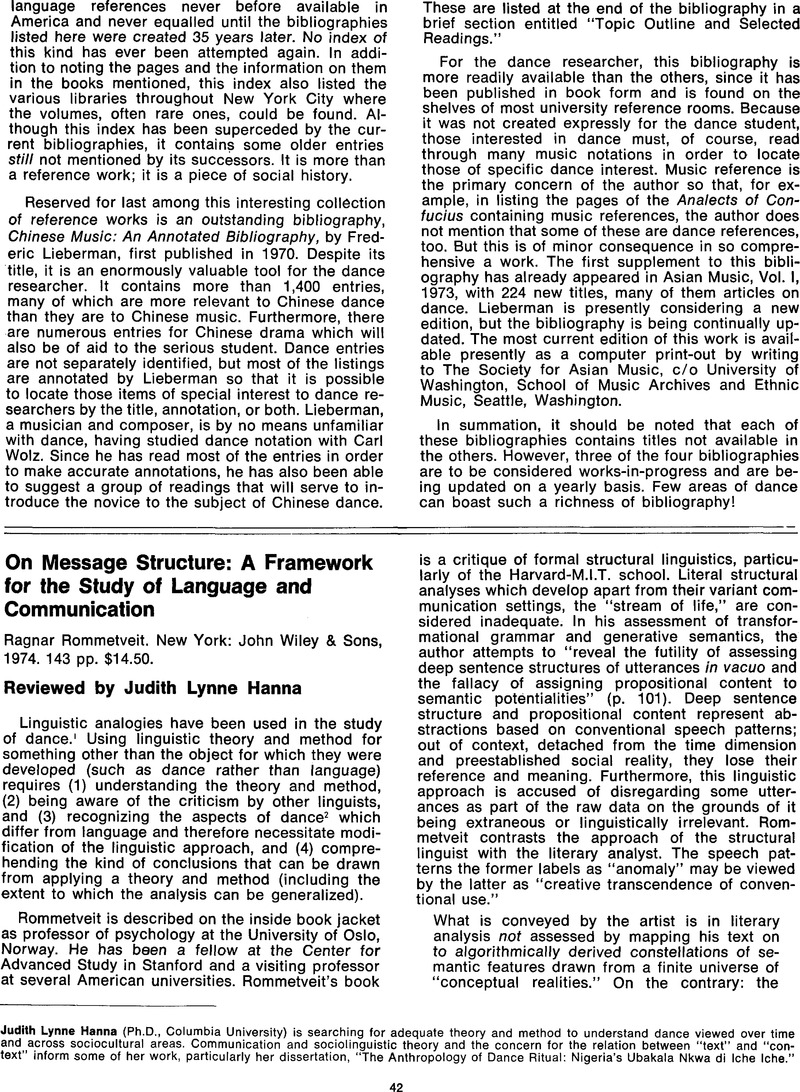No CrossRef data available.
Published online by Cambridge University Press: 22 July 2014

1. See, for example, Martin, György and Pesovár, Ernő, “A Structural Analysis of the Hungarian Folk Dance (A Methodological Sketch),” Acta Ethnographies 10:1–40, 1961Google Scholar; Ikegami, Yoshihiko, “A Stratificational Analysis of the Hand Gesture in Indian Classical Dancing,” Semiotica 4(14): 365–391, 1971CrossRefGoogle Scholar; Kaeppler, Adrienne L., “Method and Theory in Analyzing Dance Structure with An Analysis of Tongan Dance,” Ethnomusicology 16(2):173–217, 1972CrossRefGoogle Scholar; Singer, Alice, “The Metrical Structure of Macedonian Dance,” Ethnomusicology 18:379–404, 1974CrossRefGoogle Scholar; Williams, Drid, “Deep Structures of the Dance,” in Schwimmer, E., ed., Yearbook of Symbolic Anthropology, London: C. Hurst, forthcomingGoogle Scholar; Woodard, Stephanie, “Evidence for a Grammatical Structure in Dance: Examination of the Javanese Golek Lambangsari,” Dance Research Journal, this issue.Google Scholar
2. Some of these distinctive features are suggested in Hanna, , “Dances of Anahuac—For God or Man? An Alternate Way of Thinking About Prehistory,” Dance Research Journal, 7(1):13–27, 1975CrossRefGoogle Scholar; “Toward a Cross-Cultural Conceptualization of Dance and Some Correlate Considerations,” in Blacking, John, ed., The Performing Arts: Music, Dance, Theater (World Anthropology), The Hague: Mouton (forthcoming)CrossRefGoogle Scholar; “To Dance is Human: Some Psychobiological Bases of an Expressive Form,” in Blacking, John, ed. The Anthropology of the Body (A.S.A. Monographs), New York: Academic Press, forthcomingGoogle Scholar; “The Anthropology of Dance-Ritual: Nigeria's Ubakala Nkwa di Iche Iche,” Doctoral dissertation, Columbia University, 1976Google Scholar; “African Dance and the Warrior Tradition,” in Mazrui, Ali, ed., The Warrior Tradition in Modern Africa, Special Issue of Journal of Asian and African Studies, forthcomingGoogle Scholar.
3. Dance studies with this perspective include Giurchescu, Anca, “La Danse Comme Objet Semiotique,” Yearbook of the International Folk Music Council 5:175–178, 1974 and Hanna's recent workCrossRefGoogle Scholar.